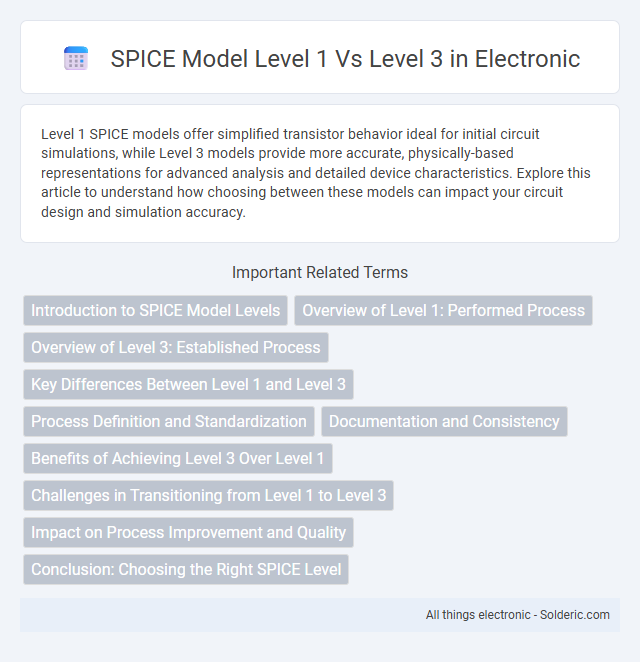Level 1 SPICE models offer simplified transistor behavior ideal for initial circuit simulations, while Level 3 models provide more accurate, physically-based representations for advanced analysis and detailed device characteristics. Explore this article to understand how choosing between these models can impact your circuit design and simulation accuracy.
Comparison Table
| Feature | SPICE Model Level 1 | SPICE Model Level 3 |
|---|---|---|
| Process Maturity | Performed process; basic implementation | Established process; defined and managed |
| Process Standardization | Limited or ad hoc processes | Defined processes with standard documentation |
| Process Measurement | Minimal or no measurement | Quantitative measurement and analysis |
| Process Control | Reactive management | Proactive process control and improvement |
| Focus Area | Basic project execution | Process definition and quality management |
| Risk Management | Informal or absent | Formal and integrated risk management |
| Documentation | Limited and inconsistent | Comprehensive and standardized |
| Continuous Improvement | Not emphasized | Institutionalized and systematic |
Introduction to SPICE Model Levels
SPICE model Level 1 defines the initial process capability, emphasizing basic project management and process control to ensure repeatability and consistent outcomes. Level 3 represents a defined process maturity, where organizational standards are established, and processes are well-documented, standardized, and integrated across projects. These levels indicate the progression from managing individual projects to implementing organization-wide process improvement and quality assurance.
Overview of Level 1: Performed Process
Level 1 of the SPICE model focuses on establishing an initial performed process where basic project management and engineering activities are carried out to achieve work goals. At this stage, Your organization demonstrates that processes are implemented but may lack consistency and measurement across projects. The key objective is to ensure that processes are followed, providing a foundation for improvement toward higher maturity levels.
Overview of Level 3: Established Process
SPICE Model Level 3, known as the Established Process, emphasizes defined and standardized processes that are tailored to the organization's needs, ensuring consistency and efficiency across projects. This maturity level requires the implementation of organizational process assets, which are continuously improved using quantitative data and feedback mechanisms. The focus on process establishment at Level 3 enhances predictability and quality in software development compared to the more reactive and inconsistent practices at Level 1.
Key Differences Between Level 1 and Level 3
SPICE Model Level 1 offers foundational process maturity assessment focused on basic project management and engineering practices, while Level 3 advances to more defined processes emphasizing organization-wide standardization and process improvement. Level 1 primarily addresses individual project performance, whereas Level 3 integrates process capability into institutional policies and benchmarks across multiple projects. The key differences lie in the scope, organizational impact, and process formalization, with Level 3 requiring extensive documentation, measurement, and continuous process improvement mechanisms absent at Level 1.
Process Definition and Standardization
SPICE Model Level 1 emphasizes basic process definition by establishing essential, repeatable processes with minimal documentation and standardization required. Level 3 introduces advanced process definition and standardization, requiring well-documented, consistent, and organization-wide processes that enable quantitative management and continuous improvement. This progression ensures stronger alignment, process integration, and higher maturity in software process management.
Documentation and Consistency
SPICE Model Level 1 emphasizes basic process documentation with limited detail, leading to inconsistent implementation across projects. Level 3 requires comprehensive and standardized documentation, ensuring consistent process application and repeatable outcomes. This mandatory rigor in Level 3 enhances organizational learning, quality control, and process improvement.
Benefits of Achieving Level 3 Over Level 1
Achieving SPICE model Level 3 signifies a robust, defined process framework with standardized and documented procedures, leading to improved process consistency and quality compared to the initial, often chaotic processes seen at Level 1. Level 3 enables better project predictability, risk management, and resource allocation, which result in enhanced product reliability and customer satisfaction. Organizations at Level 3 benefit from systematic process improvements and higher maturity, facilitating scalability and continuous performance enhancement.
Challenges in Transitioning from Level 1 to Level 3
Transitioning from SPICE model Level 1 to Level 3 involves overcoming significant process maturity challenges, including establishing consistent project management practices and integrating measurement and analysis across all projects. Organizations must invest in process standardization, training, and quality assurance to ensure repeatable and predictable outcomes. Your ability to manage change and enforce discipline across multiple projects directly impacts the successful adoption of Level 3 practices.
Impact on Process Improvement and Quality
SPICE Model Level 1 establishes fundamental process management practices, ensuring basic project control and consistency, which lays the groundwork for initial quality improvements and process standardization. Level 3 emphasizes defined processes with organization-wide standards and metrics, enabling more strategic process improvement initiatives and higher quality outcomes through systematic measurement and continuous enhancement. The progression from Level 1 to Level 3 significantly enhances an organization's capability to embed quality into processes and drive sustainable, measurable improvements in product and service delivery.
Conclusion: Choosing the Right SPICE Level
Selecting the appropriate SPICE model level hinges on the complexity of your circuit simulation needs and accuracy requirements. Level 1 offers simplified diode and transistor models suitable for basic analysis, while Level 3 provides more detailed and precise parameters accommodating advanced device behaviors. Your choice should balance computational efficiency with the fidelity necessary for reliable design outcomes.
SPICE model Level 1 vs Level 3 Infographic

 solderic.com
solderic.com